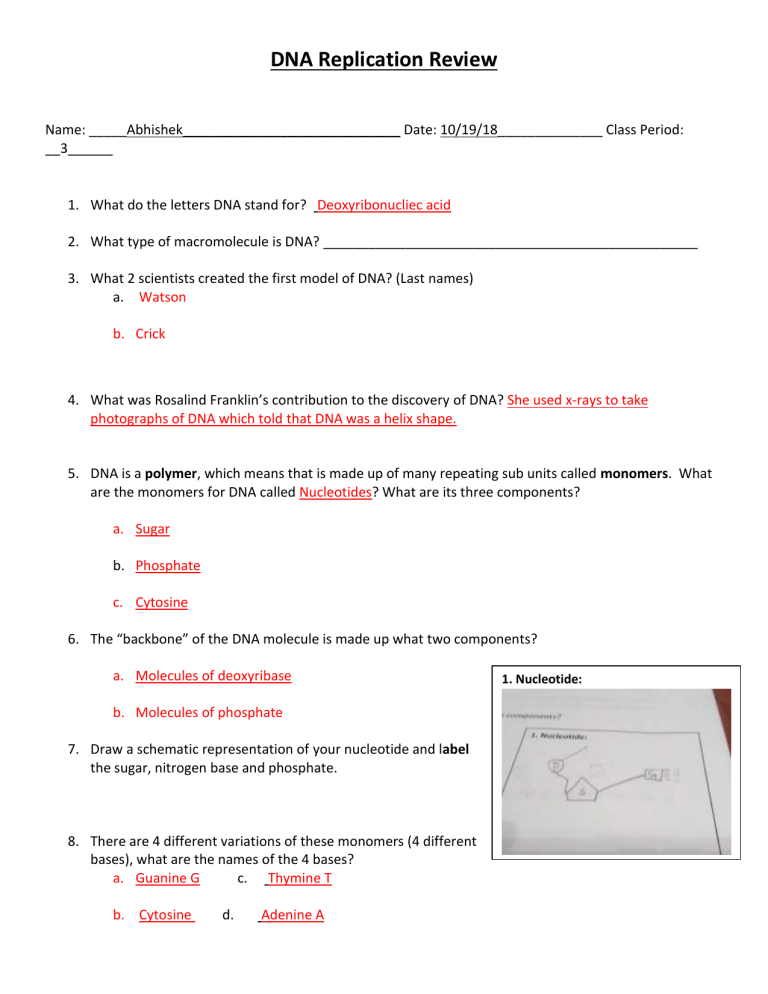DNA Replication Review
advertisement

DNA Replication Review Name: _____Abhishek_____________________________ Date: 10/19/18______________ Class Period: __3______ 1. What do the letters DNA stand for? Deoxyribonucliec acid 2. What type of macromolecule is DNA? __________________________________________________ 3. What 2 scientists created the first model of DNA? (Last names) a. Watson b. Crick 4. What was Rosalind Franklin’s contribution to the discovery of DNA? She used x-rays to take photographs of DNA which told that DNA was a helix shape. 5. DNA is a polymer, which means that is made up of many repeating sub units called monomers. What are the monomers for DNA called Nucleotides? What are its three components? a. Sugar b. Phosphate c. Cytosine 6. The “backbone” of the DNA molecule is made up what two components? a. Molecules of deoxyribase b. Molecules of phosphate 7. Draw a schematic representation of your nucleotide and label the sugar, nitrogen base and phosphate. 8. There are 4 different variations of these monomers (4 different bases), what are the names of the 4 bases? a. Guanine G c. Thymine T b. Cytosine d. Adenine A 1. Nucleotide: 9. Based on Chargaff’s rule what base pairs up with A? T, what base pairs up with C? G. This are called complementary base pairs. Thus one strand of DNA is complementary to the other strand (opposite/matching). 10. What are the complimentary base pairs to a DNA strand that has the following order: 3’A T C G C G T G A A T C G 5’ 10. DNA 11. Draw a schematic representation of an unwound DNA molecule using the first 4 base pairs from question # 9. 12. How will you remember the base pair rule? By making it and practicing it for several times. 13. Describe the structure of your DNA molecule using the terms we learned while studying its discovery. THE S inside a hexagon and p inside a circle connected to it is Sugar-Phosphate Backbone. Molecule: 14. Label the bases that are not already labeled in the image to the right. P inside a circle and s connected to it in a hexagon is Sugar-Phosphate Backbone. 15. Circle a nucleotide, put a square around a deoxyribose molecule and a triangle around a phosphate group. 16. What is the first step in the process of DNA replication? _________________________________________________________________________ _________________________________________________________________________ 17. Which enzyme is responsible for “unzipping” the DNA double helix? _________________________________________________________________________ 18. Which enzyme is responsible for facilitating the hydrogen bonding between nucleotides in a new DNA molecule? _________________________________________________________________________ _________________________________________________________________________ 19. Which enzyme is responsible for creating the covalent bonds that connect the sugar-phosphate backbone of the new DNA molecules? _________________________________________________________________________ 20. If the sequence of one single strand of DNA is 3’ C-A-A-G-T-A-G-G-C-T 5’ what is the sequence of the complementary strand? _________________________________________________________________________ 21. What type of replication is DNA? Describe the origin of each strand of the new double helices created after DNA replication. _________________________________________________________________________ _________________________________________________________________________ 22. Why is DNA replication important to the growth and development of a multi-cellular organism? _________________________________________________________________________ _________________________________________________________________________ 23. Place the following terms in the correct order from smallest to largest: Nucleosome, supercoils, coils, chromosome, DNA double helix _________________________________________________________________________ _________________________________________________________________________ 24. List the 3 basic steps of DNA replication: a. _________________________________________________________________ b. _________________________________________________________________ c. _________________________________________________________________ 25. COLOR and LABEL the diagram below: 1. ____________________ 6. ____________________ 2. ____________________ 5. __________________ 4. ____________________ 3. ____________________
